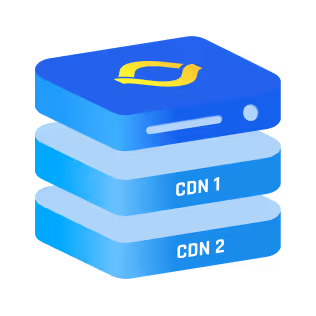Is Using a CDN Cost-effective for Small Enterprises?
Table of contents
I’ve run the numbers again and again, and the math keeps coming back the same: for any small enterprise that serves more than a trickle of traffic or has even a sliver of global audience, leaning on a cost-effective CDN is usually cheaper than pushing everything straight from your origin.
Free or “coffee-money” plans start at $0 and stretch only as far as you grow, while the speed, security, and uptime gains pay for themselves in conversion lifts and smaller infrastructure bills down the road.
I’ll walk you through the way I evaluate a CDN: what it does, what it really costs, where the traps hide, and how you can squeeze every last byte of value out of an affordable CDN plan.
Why Should You Bother with a CDN?
When I self-hosted a marketing site on a single $5 VPS in New Jersey, Asia-Pacific visitors waited an extra 1 – 1.5 seconds just for the first byte.
I could have thrown a bigger server at it, but that would have raised my base bill every month. Sliding a CDN in front of the origin shaved the wait to 200-300 ms worldwide and cut my bandwidth out of the origin by 92 %. Less load meant I could downgrade the VPS; net savings even before counting happier users.
The Money Buckets You Actually Pay For
CDN invoices come from three levers:
- Data transfer (per GB) – the headline number you see in pricing tables.
- HTTP/HTTPS requests – often free on the entry tiers, sometimes $0.007–$0.02 per 10 k on pay-as-you-go models.
- Flat plan fees – think $20/month Cloudflare Pro or $50/month Fastly’s free-tier credit.
Everything else (DDoS mitigation, TLS certs, image optimization) is bundled or optional. Ignore the marketing noise and price around those three levers.
Rough CDN Costs in 2025
Below is what I drop in my spreadsheet when I sanity-check CDN cost today. (All pricing is current to mid-2025.)
Those four cover 95 % of the cases I run into. Notice how a low cost CDN like Bunny can push 100 GB for about a buck, while CloudFront asks $8-12 for the same region mix.
The spread grows outside North America.
Should You Pay for a CDN?
Here’s the back-of-the-envelope rule I live by: if your origin bandwidth price minus CDN egress price is greater than zero, you save cash. DigitalOcean, Linode, and most regional VPS hosts still charge $0.01-0.02/GB to leave the box.
That matches Bunny’s list price and undercuts CloudFront, so I only win if the CDN slashes origin egress or unlocks a smaller server size.
Example: Your SaaS app serves 200 GB/mo, mostly marketing images and JavaScript bundles.
- VPS egress @ $0.01/GB → $2.00
- Bunny CDN @ $0.01/GB + $1 floor → $3.00
- Net +$1 but you gain global PoPs, DDoS shield, and free HTTPS. I’d still do it for the uptime insurance alone.
Switch the same workload to CloudFront and the line item jumps to ~$18. That would be great if I lived inside AWS anyway and needed its security toys.
The Hidden Fees That Can Sneak on You
I’ve absorbed a few surprise invoices, so here’s what I watch:
- Origin egress from cloud storage – pulling from S3 or GCS can double-dip. Cache aggressively to limit origin pulls.
- Image/resizing services – Cloudflare’s Polish and Bunny Optimizer can eat 2-5 $ extra per month if you leave defaults on.
- Log streaming – Fastly real-time logs are addicting and metered separately.
- Purge storms – invalidating the entire cache every deploy crushes hit-ratio; smarter versioning beats blanket purges.
Think of it this way: There’s no real downside of caching. If something can be cached, then it should be cached - unless it breaks functionality.
When You Would Not Want a CDN
You should skip the CDN entirely if:
- Nearly all revenue comes from one city and the server already sits there.
- Total data is under 5 GB/month and you don’t expect a spike (a few k brochure-site visits).
- Latency isn’t tied to conversion; think internal dashboards on the same WAN.
Even then, I sometimes put Cloudflare’s free tier in “DNS-only” mode for the free HTTPS cert and instant DDoS soak. Zero dollars, zero regrets.
When You Would Want a CDN
- You sell outside your server geo. Every 100 ms shaved can raise conversion 1 %.
- Media downloads (videos, large PDFs) cross 50–100 GB/month.
- You’re on a per-GB cloud (AWS Lightsail, Azure, GCP) where outgoing bandwidth is pricey.
- You need always-on TLS and WAF but can’t staff an ops engineer. Providers bundle those now.
That’s where an inexpensive CDN shines; you boost reliability and cut attack surface for the price of a sandwich.
How to Reduce CDN Expenses
- Pick the cheapest region tier that still covers your audience. Bunny’s “standard” network at $0.01/GB is fine unless you stream 4K.
- Cache everything static for a year and rely on file-name fingerprints to bust cache. That one tweak pushes hit-ratio above 95 %.
- Turn on Brotli/HTTP-3; these ship free on Cloudflare and chop transfer sizes 15-20 %.
- Set alert thresholds at 10 %, 50 %, 90 % of expected GB so you never read about a traffic spike in next month’s bill.
- Stage rollouts: route 10 % of traffic through the CDN first. If numbers look good, dial up to 100 %. Easy with Cloudflare’s orange-to-grey toggles.
Do those five and a CDN cheap plan stays that way.
Security Cost Benefits of CDN
I’ve watched small e-commerce sites keel over under a 5 Gbps botnet, then spin back up instantly once they flipped Cloudflare to “I’m under attack” mode.
Multiply the downtime you avoid by your revenue per hour; that’s phantom money a cheap CDN quietly puts back in your pocket.
On the flip side, browsers reward faster first-paint with higher Core Web Vitals, nudging SEO impressions. Those gains rarely show on the invoice, yet they’re real ROI.
So, Is a CDN Cost Effective For Your Business?
From where I stand, the question isn’t “can I afford a CDN?” but “can I afford the opportunity cost of not using one?”
With a mature cost-effective CDN ecosystem (some even effectively free) you can start small, pay only for what escapes cache, and sleep easier knowing downtime, slow first bytes, and surprise traffic spikes are someone else’s headache.
Tweak caching rules wisely and the service stays inexpensive, while the uptick in user experience fuels growth that would be impossible on a lone origin box.


.png)
.png)
.png)